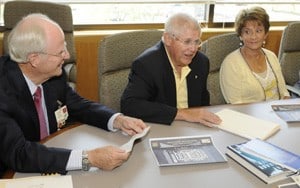Tollett Family Sees Firsthand JEI’s Plans for $3 Million Gift
Aug. 11, 2010 | Leland and Betty Tollett are most inspired that the $3 million gift they’ve pledged to the UAMS Jones Eye Institute will create a genetics clinic that will be one of only four of its kind nationwide. “We were hoping to help create something unique but I didn’t realize until today it’d be of this caliber,” said Leland Tollett, who with his wife today presented two-thirds of the Rogers couple’s pledged gift to the Jones Eye Institute. “We’re excited to be a part of this and hope to help add to the quality service they’re already known to provide.” Little Rock firm Polk Stanley Wilcox Architects formally presented the Tolletts and UAMS officials its plans for the Leland and Betty Tollett Retinal and Ocular Genetics Center, which will be on the leading edge nationally for integrating medical genetics into ophthalmologic care. The Tolletts’ gift will provide the resources to finish out the eighth floor of the Jones Eye Institute to house the center, which will include diagnostic and treatment space, low vision and rehabilitation space, clinical research and database facilities. Leland Tollett, a former two-time chief executive officer and chairman of the board of Tyson Foods Inc. of Springdale, decided to make this gift because of his lifelong interest in eye care. “Betty and I wanted to do something unique for Arkansans with vision impairment and we chose the Jones Eye Institute because of their excellent reputation as a comprehensive eye institute. We are excited about this new center’s potential,” said Leland Tollett, who served on the Jones Eye Institute Advisory Board for five years. John P. Shock, M.D., distinguished professor and founding director of the Jones Eye Institute, said there have been major discoveries in the knowledge of retinal disorders and ocular genetics in the past decade, prompting the need for the new center. “These new discoveries along with new diagnostic and therapeutic strategies have provided exciting opportunities for the prevention of vision loss,” Shock said. “If you take into account that in the next decade or so the number of patients with serious ocular conditions will double due to our growing aging population, the timing for developing a Retinal and Ophthalmic Genetic Disorders Center is ideal.” Pam Whitlock, clinic manager at the Jones Eye Institute, said a copious amount of research was done in the design process for the new eighth-floor center. “We talked to staff, patients and physicians and asked a lot of questions regarding what can be done to make this new floor as friendly and efficient as possible for patients and those providing care,” Whitlock said. “We feel like every minor detail has been addressed and are very excited to get this floor operational.” UAMS Chancellor Dan Rahn, M.D., extended Shock’s remarks about genetics being the key factor in the future of medical care and thanked the Tolletts. “Your support and engagement in this project will truly prove to be vital as the Jones Eye Institute steps forward into this emerging aspect of patient care and discovery,” Rahn said. “This is one of the unique things that can only be done at UAMS and we are honored to be a recipient of your generosity.” Aside from the clinical aspect, the Leland and Betty Tollett Center for Retinal and Ophthalmic Genetics Disorders will also have a research component. Nalini Bora, M.D., a professor and director of research in the Pat and Willard Walker Eye Research Center, will oversee the basic research component of the Center. She says some research already being done at JEI’s third-floor laboratories will overlap and aid in the kinds of research being done once the new center opens. “We have already been researching several genetics-related issues that we will expand upon once the new center is up and running,” she said. “The main goal will be to find a cure for ocular diseases such as age-related macular degeneration, glaucoma and other conditions.” Shock said the eighth floor renovation project will take up to 18 months once it gets under way, and that the Jones Eye Institute already has the team in place to help the new center grow. |


